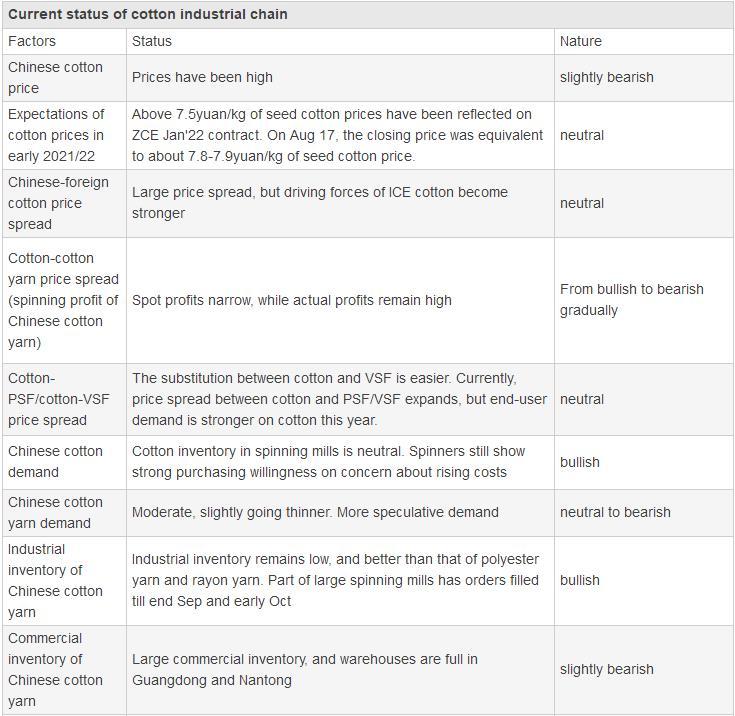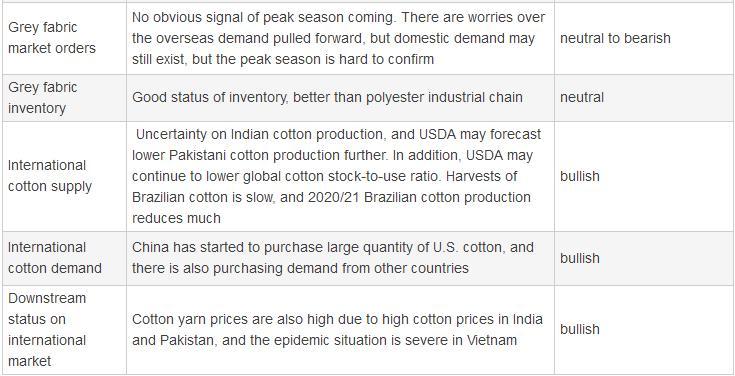Why Chinese cotton prices so strong?
Recently, polyester market shows weakness, with PSF prices falling somewhat. VSF prices are relatively stable, but its price spread with cotton continues to expand. Except spandex, cotton is extraordinary outstanding. Therefore, market players frequently ask why the price of cotton is so strong. This article analyzes the reasons and the current status quo of cotton industry.

After the China state cotton auction policy was settled in end Jun, Chinese cotton prices have been constantly rising strongly in Jul and Aug, mostly attributed to the expectations on high new seed cotton prices in beginning period of 2021/22 season caused by the fierce competition for seed cotton like last year. In 2020/21 season, seed cotton started to procure from mid-to-late Sep in Xinjiang, and large quantity of cotton arrived on the market during National Day holiday (Oct 1-8, 2020). Due to increasing ginning capacities in Xinjiang (more than 100 new lines last year), ginning factories competed for purchasing seed cotton, and seed cotton prices rose rapidly during the National Day holiday. New cotton costs were higher about 2,000yuan/mt than ZCE cotton futures at that time. In the meantime, end-users replenished stocks in advance with worries over rising costs, and actual demand also came from Double 11 and expectations of cold winter, leading to the upswing of cotton prices from Oct 2020 to Feb 2021. After the Chinese Lunar New Year holiday, cotton prices slumped in Mar, 2021, as end-users were hesitant to conclude orders and macro risks were seen from surging U.S. yield and higher U.S. dollars. In Apr-Jun, cotton prices were relatively stable amid the inflation and government control on macro commodity prices. After the China state cotton auction was settled in end Jun, market players expected that 2021/22 Chinese cotton production might decrease in 2021/22 season, and planting costs of new cotton climbed up, while ginning capacities remained high, so market players anticipated a similar market situation like last year and reacted first on cotton futures market.
In the other major cotton producing countries outside China, Brazilian and Pakistani cotton production is supposed to reduce much, and there are also uncertainties on the production of U.S. and Indian cotton. Moreover, downstream market is not poor during Mar and Aug. Industrial stocks of cotton yarn have not piled up. Downstream buyers replenish more cotton or replenish cotton in advance with the expectations of tight supply, which causes higher cotton prices. In summary, in the cotton industrial chain, cotton prices are more reflected the expectations of tightening supply, while PSF and VSF markets have no such obvious supply and demand contradiction like cotton market, so they have no outstanding situation.


We have analyzed the major factors influencing cotton prices and the current status in cotton industrial chain. Though there is no obvious signal of peak season coming and there are worries about the overseas demand pulled forward, downstream spinning mills have to use cotton with high costs, and cotton yarn traders may not sell stocks quickly (the stocks that are replenished previously have high profits). Cotton yarn has many new capacities, and with high operating rate, the demand for cotton is supposed to remain large. Chinese cotton prices may fall down somewhat, but in long run, the upward trend is not supposed to change.
- Top keywords
- Cotton Price
- Cotton Futures Price
- Cotton Futures
- CZCE
- PTA Futures Price
- Chemical Fiber
- Polyester Prices
- Wool price
- PTA Futures
- Shengze Silk
- China
- Yarn Price
- price
- China Textile City
- Fibre Price
- Benzene Price
- Cotton
- Index
- Cotton Index
- PTA
- fabric price
- NYMEX
- Top 10
- textile industry
- Spot Cotton
- Cotton Yarn
- Polyester Price
- Futures
- PTA Price
- cotton yarn price

